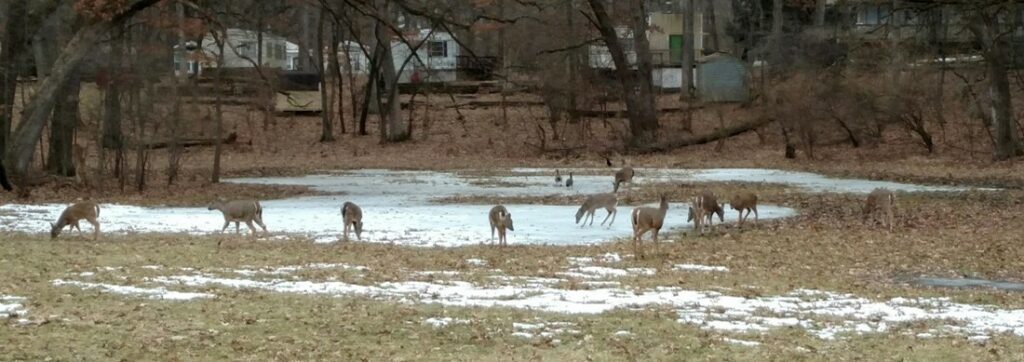
Deer Herd
Seen off of Greenbriar, March 6, 2020
The white-tailed deer is a beautiful animal for owners and guests to view here on property. These animals are doing very well throughout the State. Woodhaven has become, in essence, a “sanctuary” for the animals throughout the year. It is not uncommon in any season for those driving the roads on property to see large groups of deer. This can also present problems for our ecological balance as well as for the deer herd itself.
Currently, the white-tailed deer population is abundant throughout the State of Illinois and US. In stark contrast, in 1912, the deer population of Illinois was deemed “extinct.” Up to the late 1800s, deer populations throughout Illinois had been heavily hunted as there were no laws in place to protect them or other game. Along with the unregulated hunting pressure, there was extensive disruption of the landscape due to intensive farming practices, draining of wetlands and clearing of woodlands. Here is an excerpt from the website, “White-Tailed Deer Illinois”:
“1901 Illinois imposed a “temporary” moratorium on deer hunting to last five years so the populations could recover and increase. Rather than increase, however, the population continued to decline throughout the state. For all practical purposes, the white-tailed deer disappeared from Illinois. The “temporary” closure lasted 56 years.” (https://deer.wildlifeillinois.org/management/history-of-management/)
We have had an abundance of deer in the State as far back as most of us can remember. What led to the successful recovery of the deer population from the point of extinction in Illinois? Following is a brief history of the management steps that brought the white-tail deer back to abundance.
The first wildlife refuge was established at Horseshoe Lake in Alexander County in1927 by the newly formed Illinois Department of Conservation. The first reported release of deer, one buck and three does, took place at this refuge in 1933. Shortly after, in 1935, three does and two bucks were obtained from the Michigan Department of Conservation and released into the Shawnee National Forest in Pope County by the U.S. Forest Service. Through live capture and releases into new areas that occurred throughout the State in the 1930s, the deer population began to recover. This was in conjunction with other conservation laws and acts to help establish funding for the newly formed Department of Conservation. Most notable was the establishment of the requirement for hunters to purchase a license.
The sales of hunting licenses helped fund the continued efforts to re-establish the deer population in the State of Illinois. Revenue from license sales allowed game wardens to be enlisted for the enforcement of game laws. These game laws established set seasons and quotas on the number of animals that could be taken legally.
Deer populations continued to increase, and by 1947, Conservation officers reported deer had been observed in 45 of Illinois’ 102 counties. The State ranked 46th out of the 50 states in the number of white-tailed deer with a total of 365 animals. By 1950, the State deer population was estimated to be 3,100. The numbers of deer were still “low” but increasing.
The first Illinois deer hunting season began in 1957, October 1 – 15 with 2,617 bow and arrow hunting permits issued. Two hundred twenty (220) deer were harvested in that first season. In the 1960s, the statewide deer population was estimated to be 19,195. By 1991, the deer harvest for all seasons exceeded 100,000 for the first time. The deer herd continued to increase statewide even with expanded hunting seasons through the 2000s.
The deer population statewide in the late 1990s and 2000s became overabundant as deer vehicle accidents increased dramatically during this period. To manage the increasing numbers, hunting was expanded along with deer quotas. The purpose was to reduce the numbers of deer-vehicle accidents. In addition, disease began to appear in the deer herds creating concerns for the overall health of the animals. High populations are conducive to an increase in disease transmission.
In 2002 the first occurrence of the disease, Chronic Wasting Disease (CWD), was discovered in Boone County, Illinois. This county is located in the northern part of the state. Chronic Wasting disease infects animals in the cervidae family. The cervids includes white-tailed deer, elk, and moose.
Chronic Wasting Disease is a very serious condition in the white-tail deer population within the state of Illinois. Deer that have the disease eventually succumb to it. The disease is spread through direct contact with infected individuals or by feeding in areas used by an infected animal. To learn more about this disease in Illinois, please read the post “Zombie Deer in Illinois: Fact vs Fiction” by Shannon Callahan.